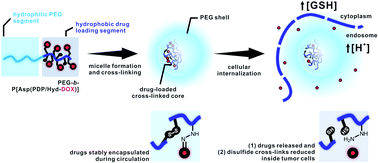Reversibly core cross-linked polymeric micelles with pH- and reduction-sensitivities: effects of cross-linking degree on particle stability, drug release kinetics, and anti-tumor efficacy†
Abstract
A doxorubicin-conjugated disulfide cross-linked PEG-b-P[Asp(Hyd-DOX)] micelle drug delivery system was employed in this study to investigate the effects of cross-linking degree on particle stability, pH-dependent drug release, and in vivo anti-tumor efficacy. Cross-linked polymeric micelles demonstrated superior particle stability and slower drug release kinetics compared with the non-cross-linked counterparts in the absence of reducing agents in a cross-linking level-dependent manner. Once the cross-links were cleaved due to the action of dithiothreitol, both cross-linked and non-cross-linked polymeric micelles behaved similarly in terms of stability and drug release. In vitro cytotoxicity of doxorubicin-conjugated micelles was observed to decrease gradually with increasing degree of cross-linking. While both cross-linked and non-cross-linked polymeric micelles caused tumor regression in mice bearing subcutaneous 4T1 breast tumors, polymeric micelles with a 25% cross-linking degree increased the tolerated dose of doxorubicin by 33%. These findings suggest that reversible core cross-linking of polymeric micelles through disulfide linkages is beneficial to the control of drug release and reduction in systemic toxicity caused by doxorubicin.


 Please wait while we load your content...
Please wait while we load your content...